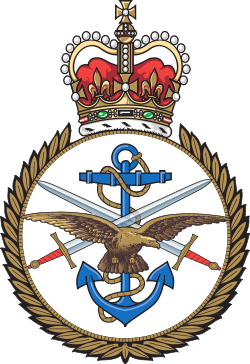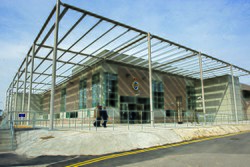History
Major General Christopher Wallace led the team that began establishing the headquarters from 1994. [1] "Senior officers in the Army and RAF did not welcome this initiative and Wallace had to deploy his considerable skills of advocacy to win that battle" [1] (to establish the new joint headquarters).
The Permanent Joint Headquarters was established on 1 April 1996 to enhance the operational effectiveness and efficiency of UK-led joint, potentially joint and multi-national operations, and to exercise operational command of UK forces assigned to multinational operations led by others. [2] Wallace was appointed as CJO in the rank of lieutenant general. The PJHQ started to assume responsibility for military operations worldwide (fully operational) on 1 August 1996. [3] The 35-hectare Northwood Headquarters site has belonged to the RAF since 1938. [4]
By mid-1998, a short-notice deployable headquarters commanded by a Brigadier-equivalent officer, the Joint Force Headquarters (JFHQ) was being established within PJHQ. The JFHQ was an outgrowth of the PJHQ's J3 Operations staff. The JFHQ was described as 'capable of deploying into the field at very short notice,' by its first commander, Brigadier David Richards. Richards was appointed as Chief Joint Rapid Deployment Force Operations, and also to expand the concept that underpinned its creation, the Joint Rapid Reaction Forces. [5] The JRRFs were to be "a pool of highly capable force elements, maintained at high and very high readiness," [6] from which the UK was to meet all short notice contingencies. Initially planned to have a staff of 24, Richards expanded the JFHQ to 55 strong, 'something our training and experience on exercise was proving necessary.' [7]
In 2007-2008, the PJHQ' s budget was estimated around £475 million. [3]
In 2010, the PJHQ and its 600 staff officers and enlisted personnel moved to a contemporary building in Northwood, London. [8] [9] For the first time, all PJHQ staff were gathered under the same roof. [4]
Among the operations supervised by PJHQ have been Operation Veritas (Afghanistan, 2001); Operation Telic (2003 invasion of Iraq); Operation Herrick (UK operations in Helmand Province, Afghanistan, from 2006); and Operation Pitting (evacuation of UK nationals and at-risk Afghanistanis from Kabul in 2021). [10]
Mission and duties
The PJHQ's mission is as follows: [11]
"CJO is to exercise operational command of UK forces assigned to overseas joint and combined operations; and to provide politically aware military advice to the MOD in order to achieve MOD UK’s strategic objectives on operations"
PJHQ operates cyber operations in coordination with the Government Communications Headquarters in Cheltenham. [12]
There are certain areas that the headquarters will not be involved in: [11]
As of November 2022, there were 567 military and civil service personnel assigned to PJHQ. [13]
This page is based on this
Wikipedia article Text is available under the
CC BY-SA 4.0 license; additional terms may apply.
Images, videos and audio are available under their respective licenses.

